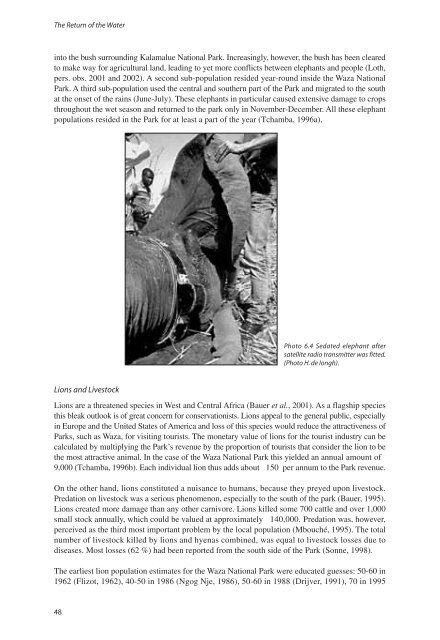The return of the water - IUCN
The return of the water - IUCN
The return of the water - IUCN
You also want an ePaper? Increase the reach of your titles
YUMPU automatically turns print PDFs into web optimized ePapers that Google loves.
<strong>The</strong> Return <strong>of</strong> <strong>the</strong> Water<br />
into <strong>the</strong> bush surrounding Kalamalue National Park. Increasingly, however, <strong>the</strong> bush has been cleared<br />
to make way for agricultural land, leading to yet more conflicts between elephants and people (Loth,<br />
pers. obs. 2001 and 2002). A second sub-population resided year-round inside <strong>the</strong> Waza National<br />
Park. A third sub-population used <strong>the</strong> central and sou<strong>the</strong>rn part <strong>of</strong> <strong>the</strong> Park and migrated to <strong>the</strong> south<br />
at <strong>the</strong> onset <strong>of</strong> <strong>the</strong> rains (June-July). <strong>The</strong>se elephants in particular caused extensive damage to crops<br />
throughout <strong>the</strong> wet season and <strong>return</strong>ed to <strong>the</strong> park only in November-December. All <strong>the</strong>se elephant<br />
populations resided in <strong>the</strong> Park for at least a part <strong>of</strong> <strong>the</strong> year (Tchamba, 1996a).<br />
Lions and Livestock<br />
Lions are a threatened species in West and Central Africa (Bauer et al., 2001). As a flagship species<br />
this bleak outlook is <strong>of</strong> great concern for conservationists. Lions appeal to <strong>the</strong> general public, especially<br />
in Europe and <strong>the</strong> United States <strong>of</strong> America and loss <strong>of</strong> this species would reduce <strong>the</strong> attractiveness <strong>of</strong><br />
Parks, such as Waza, for visiting tourists. <strong>The</strong> monetary value <strong>of</strong> lions for <strong>the</strong> tourist industry can be<br />
calculated by multiplying <strong>the</strong> Park’s revenue by <strong>the</strong> proportion <strong>of</strong> tourists that consider <strong>the</strong> lion to be<br />
<strong>the</strong> most attractive animal. In <strong>the</strong> case <strong>of</strong> <strong>the</strong> Waza National Park this yielded an annual amount <strong>of</strong><br />
9,000 (Tchamba, 1996b). Each individual lion thus adds about 150 per annum to <strong>the</strong> Park revenue.<br />
On <strong>the</strong> o<strong>the</strong>r hand, lions constituted a nuisance to humans, because <strong>the</strong>y preyed upon livestock.<br />
Predation on livestock was a serious phenomenon, especially to <strong>the</strong> south <strong>of</strong> <strong>the</strong> park (Bauer, 1995).<br />
Lions created more damage than any o<strong>the</strong>r carnivore. Lions killed some 700 cattle and over 1,000<br />
small stock annually, which could be valued at approximately 140,000. Predation was, however,<br />
perceived as <strong>the</strong> third most important problem by <strong>the</strong> local population (Mbouché, 1995). <strong>The</strong> total<br />
number <strong>of</strong> livestock killed by lions and hyenas combined, was equal to livestock losses due to<br />
diseases. Most losses (62 %) had been reported from <strong>the</strong> south side <strong>of</strong> <strong>the</strong> Park (Sonne, 1998).<br />
<strong>The</strong> earliest lion population estimates for <strong>the</strong> Waza National Park were educated guesses: 50-60 in<br />
1962 (Flizot, 1962), 40-50 in 1986 (Ngog Nje, 1986), 50-60 in 1988 (Drijver, 1991), 70 in 1995<br />
48<br />
Photo 6.4 Sedated elephant after<br />
satellite radio transmitter was fitted.<br />
(Photo H. de Iongh).












